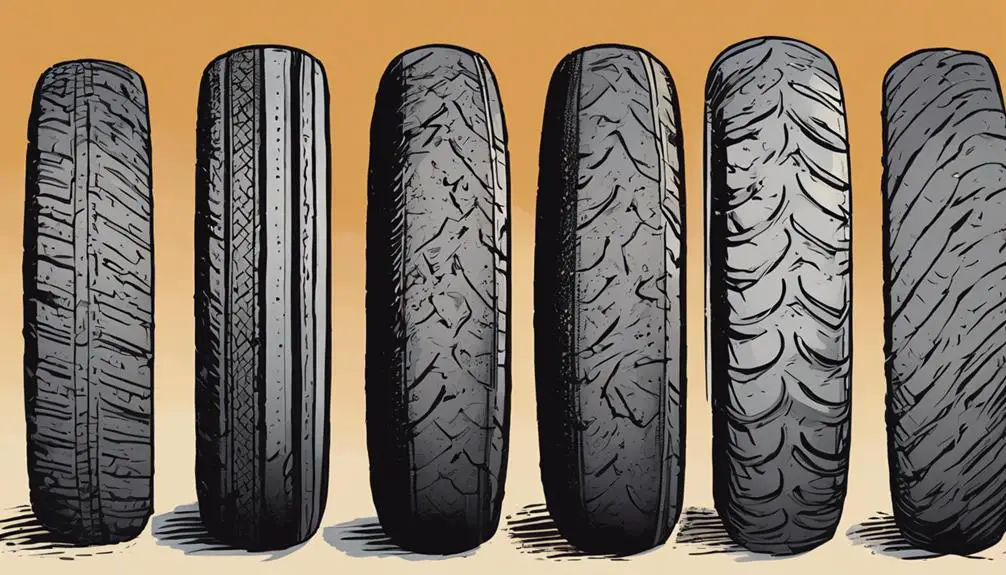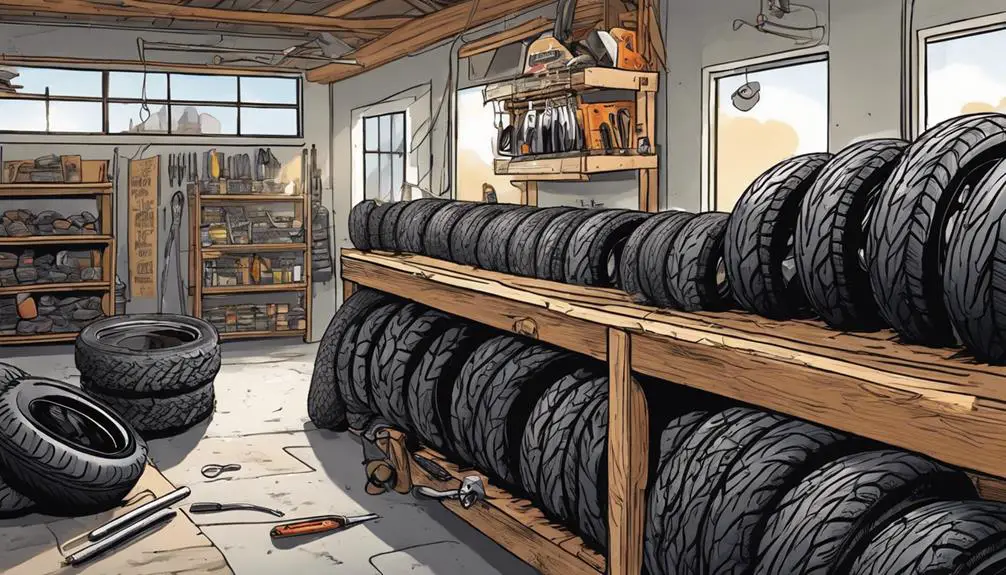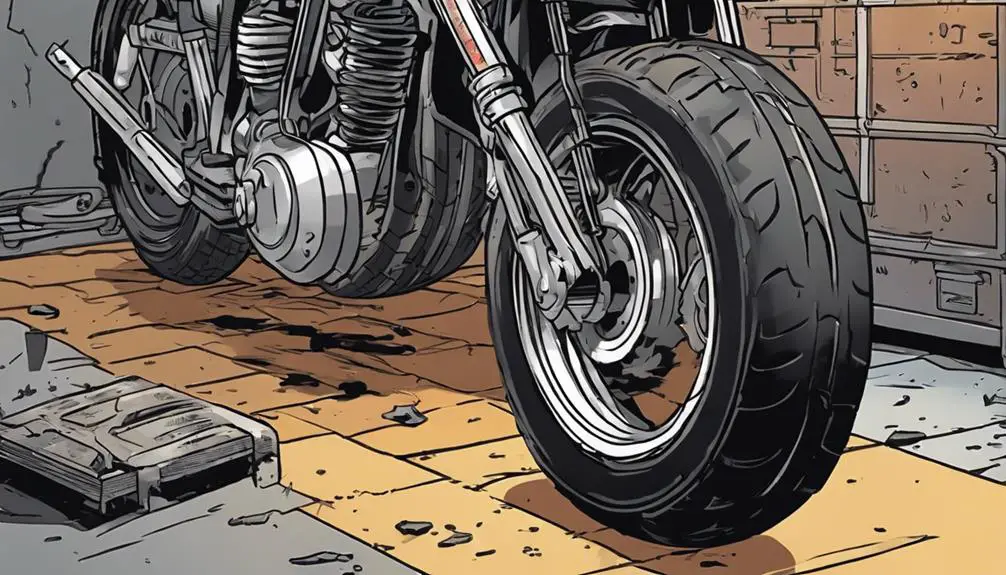Did you know that nearly 30% of motorcycle accidents involve tire-related issues? Keeping your tires in top shape is essential for both safety and performance, yet many riders overlook this critical aspect. You might be surprised by how simple tire care can enhance your riding experience. From checking tire pressure to understanding wear patterns, there are several key practices to guarantee your motorcycle is ready for the road. What are the most effective tire care tips that can help you avoid potential hazards and extend the life of your tires?
Quick Takeaways
- Regularly check tire pressure, ideally before each ride, to ensure optimal handling and safety.
- Inspect tire tread depth using a gauge or the penny test to determine if replacement is needed.
- Look for signs of tire damage, such as cracks, blisters, or uneven wear, and address issues promptly.
- Clean tires after rides to remove dirt and debris, preventing corrosion and maintaining performance.
Importance of Tire Maintenance

Maintaining your motorcycle tires is essential for ensuring safety and ideal performance on the road. Your tires are your only contact with the asphalt, so keeping them in top shape allows you to experience the thrill of freedom that comes with riding. Proper tire maintenance not only enhances your bike's handling but also maximizes fuel efficiency, letting you ride further without constantly worrying about refueling.
You'll want to regularly check for wear and tear, as well as any visible damage that might compromise your ride. A well-maintained tire improves grip, allowing you to navigate curves and sudden stops with confidence. This control is key in feeling the liberation that comes with mastering your machine.
Inspecting Tire Pressure
Checking your motorcycle's tire pressure is essential for safe riding.
You should know the ideal pressure range and make it a habit to check it regularly.
Riding on improperly inflated tires can lead to reduced performance and increased wear, so let's explore how to keep your tires in top shape.
Ideal Tire Pressure Range
To guarantee ideal performance and safety, it's crucial to regularly inspect your motorcycle's tire pressure within the manufacturer's recommended range. This range isn't just a suggestion; it's your lifeline to freedom on the open road. When tires are inflated properly, you enhance handling, fuel efficiency, and overall ride quality.
Too low, and you risk the tires overheating, which can lead to a blowout and endanger your ride. Too high, and your tires could wear unevenly, compromising stability and control. You want to feel the thrill of every twist and turn, not the anxiety of poor tire health.
Make it a habit to check your tire pressure before each ride. Use a reliable gauge, as it'll give you the precise reading you need. If you find yourself outside the ideal range, adjust the pressure accordingly.
Recommended Pressure Checks
Regularly inspecting your motorcycle's tire pressure guarantees you're always ready for the road ahead.
Keeping your tires properly inflated not only enhances your ride but also guarantees your safety and freedom on the open road.
Here's how to make tire pressure checks a part of your routine:
- Check the Pressure: Use a reliable pressure gauge to measure your tire pressure when tires are cold, ideally before your ride.
- Know the Recommended PSI: Refer to your motorcycle's manual or the sticker on the frame for the ideal pressure range. This knowledge empowers you to make informed adjustments.
- Inspect Regularly: Make it a habit to check your tire pressure at least once a month or before long trips. Consistency is key to maintaining peak performance.
- Adjust as Needed: If your tire pressure is low, inflate it to the recommended level. If it's too high, let some air out. You're in control of your ride.
Effects of Improper Pressure
Improper tire pressure can lead to serious handling issues, increasing your risk of accidents and reducing your motorcycle's overall performance. When your tires are under-inflated, they create more friction with the road, causing them to overheat. This not only shortens tire life but can also lead to blowouts, putting you in a dangerous situation.
On the flip side, over-inflated tires can make your ride feel harsh and unstable, compromising your grip on the road. You want to feel free and in control as you navigate the twists and turns of the open road, but improper tire pressure can strip that away.
Regularly checking and adjusting your tire pressure guarantees your bike responds precisely to your commands. It keeps your ride smooth, your tires lasting longer, and your safety intact.
Make it a habit to inspect your tire pressure before each ride. Use a reliable gauge and adjust as needed. Remember, maintaining the right pressure isn't just about performance; it's about liberating your ride and embracing the thrill of the journey with confidence.
Don't let improper pressure hold you back—take charge of your motorcycle's care!
Understanding Tire Wear Patterns

Understanding tire wear patterns is essential for your safety and performance on the road.
You'll want to recognize common wear types, identify the causes of uneven wear, and check your tread depth regularly.
Common Tire Wear Types
Tire wear patterns can reveal a lot about your motorcycle's handling and maintenance needs. By understanding these patterns, you can take charge of your ride and guarantee a smooth, safe experience on the open road.
Here are four common tire wear types you should know:
- Center Wear: This occurs when the tread in the middle of the tire wears down quicker than the edges, often indicating over-inflation or excessive straight-line riding.
- Edge Wear: If you notice the outer edges of your tires wearing down faster, it might suggest that you're taking those corners too aggressively or under-inflating your tires.
- Cup Wear: This pattern looks like small dips around the tread and often signals that your bike's suspension needs attention or that your tires are out of balance.
- Patch Wear: This is uneven wear in specific spots, which can indicate alignment issues or that your tires are facing irregular stress.
Causes of Uneven Wear
Uneven tire wear can stem from several factors, including riding habits, tire pressure, and motorcycle maintenance.
If you're aggressive on the throttle or take sharp corners too quickly, you'll likely notice wear on the outer edges of your tires. Smooth, controlled riding not only enhances your experience but also prolongs tire life.
Tire pressure plays a significant role, too. Under-inflated tires can lead to excessive wear on the edges, while over-inflated tires wear out the center more quickly. It's essential to check your tire pressure regularly to maintain balance and control.
Neglecting routine maintenance can also contribute to uneven wear. Regularly inspect your suspension and alignment; if these aren't in top shape, your tires won't make even contact with the road.
You've got the freedom to ride, but taking care of your tires is part of that journey. By understanding and addressing these factors, you not only enhance your riding experience but also guarantee your motorcycle performs at its best.
Keep your tires in check, and you'll feel the difference on every ride.
Identifying Tread Depth
Knowing how to identify tread depth is essential for ensuring your motorcycle tires grip the road effectively and provide a safe riding experience.
Tread depth directly impacts your bike's handling and braking. Here's how you can check it:
- Use a Tread Depth Gauge: This is the most accurate tool for measuring tread depth. Insert it into the grooves to get a precise reading.
- The Penny Test: Insert a penny into the tread with Lincoln's head facing down. If you can see all of his head, it's time for new tires.
- Look for Wear Indicators: Most tires have small raised indicators in the tread. When the tread wears down to the same level as these indicators, it's time to replace the tire.
- Check for Uneven Wear: Inspect the tread for uneven patterns. This can signal alignment issues or improper inflation, which need to be addressed for peak performance.
Choosing the Right Tire Type
Selecting the right type of motorcycle tire can considerably enhance your riding experience and safety on the road. Your choice directly impacts handling, grip, and overall performance.
Begin by considering your riding style. If you crave the thrill of twisty mountain roads, look for sport tires that offer exceptional grip and responsiveness. For those who prefer long-distance cruising, touring tires provide a smoother ride and greater durability.
Don't forget about the weather conditions you'll face. If you're often riding in wet or slippery conditions, opt for tires designed with deeper treads and specialized rubber compounds to maintain traction. For off-road adventures, select dual-sport or off-road tires that can tackle rough terrain while still providing some on-road capability.
Pay attention to your motorcycle's specifications as well. Each bike has recommended tire types, widths, and aspect ratios that guarantee peak performance.
Finally, remember that tire pressure also plays a vital role in how your tires perform. No matter which type you choose, maintaining proper air pressure is essential for safety and longevity.
Embrace the freedom of the road by making informed tire choices that match your spirit of adventure.
Proper Tire Storage Techniques

Once you've chosen the right tires for your motorcycle, proper storage techniques can help maintain their condition and longevity when they're not in use. Taking a few simple steps can make a world of difference in keeping your tires in top shape, guaranteeing you're ready to hit the road whenever the spirit calls.
Here are four essential tips for effective tire storage:
- Clean the Tires: Remove dirt and debris before storing. This prevents corrosion and damage.
- Store in a Cool, Dry Place: Avoid direct sunlight and humidity. A shaded, temperature-controlled area works best.
- Position Properly: If you're storing the tires upright, guarantee they're standing vertically. If stacked, keep them flat and avoid compressing them too tightly.
- Check Tire Pressure: Before storing, inflate your tires to the recommended pressure. This helps maintain their shape and prevents flat spots.
Cleaning and Maintaining Tires
To keep your motorcycle tires in peak condition, regular cleaning and maintenance are essential practices that every rider should adopt.
Start by wiping down your tires after each ride. Use a soft cloth to remove debris, grime, and any road residue that might affect performance. Don't forget to check the tire pressure regularly; properly inflated tires enhance handling and safety.
Next, use a gentle soap solution to wash your tires, ensuring you reach every nook and cranny. Avoid harsh chemicals, as they can damage the rubber. Rinse thoroughly and let them dry in the shade to prevent cracking from the sun's direct rays.
Additionally, inspect your tires for uneven wear or embedded objects. Keep an eye on the tread depth; it's crucial for grip and stability. If you notice any irregularities, it might be time to rotate or replace them.
Lastly, consider applying a tire dressing to protect against UV rays and maintain that rich, black appearance. By following these steps, you not only prolong the life of your tires but also enjoy the freedom of the open road with confidence.
Embrace the ride, knowing you've got your tires covered!
Signs of Tire Damage

Recognizing the signs of tire damage is essential for maintaining your motorcycle's safety and performance on the road. Ignoring these signs can lead to dangerous situations and limit your freedom on two wheels. Here's what to look out for:
- Cracks or Cuts: Inspect your tires for visible cracks or cuts in the rubber. These can compromise the tire's integrity and lead to blowouts.
- Uneven Wear: Check for uneven tread wear, which could indicate alignment issues or improper inflation. Your tires should wear evenly across their surface for ideal grip.
- Bubbles or Blisters: Look for any bulges or blisters on the tire surface. These are signs of internal damage, and riding on them can be risky.
- Low Tread Depth: Use the penny test to check your tread depth. If you can see all of Lincoln's head, it's time to take action.
When to Replace Tires
Knowing when to replace your motorcycle tires is just as important as spotting signs of damage, as worn tires can greatly affect your safety and performance.
First off, check the tread depth. If it's worn down to 2/32 of an inch or less, it's time to get new tires. You can use a tread depth gauge or the penny test—if you can see all of Lincoln's head, it's time for a change.
Next, look out for cracks or bulges on the sidewalls. These indicate structural weakening and can lead to blowouts. If you notice uneven wear patterns, it might mean your bike needs an alignment or you need to adjust your riding style.
Tires generally have a lifespan of about five years, even if the tread looks good. Always check the manufacturer's date on the sidewall. If you've been riding hard or on rough terrain, consider replacing them sooner.
Common Questions
How Often Should I Check My Motorcycle Tire Pressure?
You should check your motorcycle tire pressure at least once a month, but it's best to do it before every ride. This guarantees your tires are properly inflated for peak performance and safety.
If you've been riding hard or experiencing temperature changes, check them more often.
Can I Mix Different Tire Brands on My Motorcycle?
Mixing different tire brands on your motorcycle can feel like riding a tightrope, balancing performance and safety. While it might seem tempting for a quick fix, it's not ideal.
Each brand has unique designs and compounds, affecting grip and handling. You want your ride to feel liberating, not precarious.
Stick to matching brands or at least similar types to guarantee your journey is smooth and secure, allowing you to embrace the open road with confidence.
What Is the Ideal Tire Pressure for My Motorcycle?
You've gotta keep your motorcycle's tire pressure in check to guarantee a smooth ride.
The ideal pressure usually sits between 30-40 PSI, but it varies by model. Check your owner's manual for specifics.
Don't forget to measure when tires are cold for the most accurate reading.
Maintaining proper pressure not only boosts performance but also enhances safety, so you can ride free and confidently on the open road.
How Do Weather Conditions Affect Motorcycle Tire Performance?
Weather conditions can notably impact your motorcycle's tire performance.
In wet or cold conditions, your tires lose grip and responsiveness, making it harder to control your ride.
When it's hot, tire pressure can rise, affecting handling.
You should check your tire pressure regularly, especially during temperature changes.
Embracing the freedom of the open road means being aware of these factors, so you can ride safely and confidently, no matter the weather.
Is It Safe to Ride on a Flat Tire Temporarily?
Riding on a flat tire might seem tempting, but it's a gamble you shouldn't take. You might feel a rush, but the danger lurks beneath.
Your bike's handling will suffer, and you could lose control. It's not just about the ride; it's about your safety and freedom.
Don't let a flat tire tether you down. Instead, pull over, assess the situation, and give your bike the care it deserves before hitting the road again.
Wrapping Up
Taking care of your motorcycle tires isn't just about safety; it's about enhancing your ride.
By regularly checking tire pressure, understanding wear patterns, and knowing when to replace them, you're investing in your bike's performance.
Don't forget to clean and store them properly to extend their lifespan.
Remember, a well-maintained tire means better handling and a smoother journey.
So, embrace these tire care tips, and you'll hit the road with confidence, knowing you're prepared for whatever comes your way.